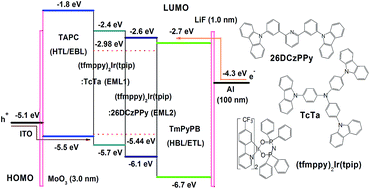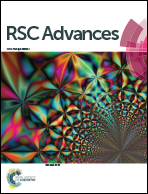Green organic light-emitting devices with external quantum efficiency up to nearly 30% based on an iridium complex with a tetraphenylimidodiphosphinate ligand
Abstract
In this work, a series of electroluminescent (EL) devices with single- or double-light-emitting layer(s) (EML) were fabricated to further improve the EL performances of green iridium complex (tfmppy)2Ir(tpip) (tfmppy = 4-trifluoromethylphenylpyridine, tpip = tetraphenylimido-diphosphinate). p-Type material 4,4′,4′′-tri-s(carbazole-9-yl)triphenylamine and bipolar material 2,6-bis(3-(9H-carbazol-9-yl)phenyl)pyridine were chosen as host materials of EML1 and EML2, respectively. Experimental results displayed that not only the doping concentration but also the thicknesses of EML and the electron transport layer strongly influence device performances. Finally, a high performance green EL device with maximum brightness, current efficiency, power efficiency and external quantum efficiency (EQE) up to 113 610 cd m−2, 112.30 cd A−1, 97.95 lm W−1 and 29.4%, was realized. Even at the practical brightness of 1000 cd m−2, current efficiency as high as 107.6 cd A−1 (EQE = 28.1%) can still be retained by the same device. To our best knowledge, EL performances of this device were amongst the highest results of the previously reported green devices.

- This article is part of the themed collection: Luminescence and photophysical properties of metal complexes

 Please wait while we load your content...
Please wait while we load your content...